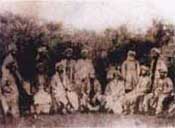By Monty Siddique for The News Today
 Abu Saleh Mohammad Siddique, whose ancestral home was in Tetulia (Zamindar family), Satkhira, Bangladesh, studied English Language and English Literature at St. Xavier’s College, Kolkata. He breathed his last in June 2007 and is buried in the Muslim section of the Greenford Cemetery in the London Borough of Ealing.
Abu Saleh Mohammad Siddique, whose ancestral home was in Tetulia (Zamindar family), Satkhira, Bangladesh, studied English Language and English Literature at St. Xavier’s College, Kolkata. He breathed his last in June 2007 and is buried in the Muslim section of the Greenford Cemetery in the London Borough of Ealing.
Going over the pages of history of over a hundred or so years ago reveals the names of a pool of Bengali scholars and civil servants in British India of whom we should be proud. These scholars and civil servants project a rich history of Bengal, in general, and Bangladesh, in particular, of which our present generation should be aware in order that they exude confidence apropos the history and heritage of Bengal, increase their sense of belonging, gear themselves to achieving bigger things and relay this positive image to the outside world. This encouraging chapter spanning the period of 19th- and 20th-century British India illustrates how methodical, efficient and fit for purpose the administration was at the time.
History is made by people by way of their contributions to the society at large and the legacies they leave behind. What more absorbing way is there to enlighten us with their legacies than to read their obituaries and learn about their life histories?
Many, outside Bangladesh, be they Europeans or even people from the South Asian diasporas, have come to perceive Bengal, in general, and Bangladesh, in particular, as only a land of poverty and floods and a Malthusian nightmare of a population explosion. Unfortunately, this is also the picture that seems to have been ingrained in the minds of some within Bangladesh. The fact that Bengal was the breadbasket of the whole of India during the British Raj and earlier has somehow eluded the minds of us Bengalis. However, if we only go back a hundred to two hundred years ago into the historical past, we are pleasantly surprised to discover a gradually increasing population in the Bengali intelligentsia in British India whose dedicated contributions paved the way for a strong foundation for progress in the academic and civil administration arenas. Clearly, it is also a credit to the British Indian administration at the time, insofar as they acknowledged the contributions of these evolving Bengali personalities.
One such notable Bengali Muslim personality of 19th- and 20th-century British India was Shams-ul-Ulama Maulvi Abul Khair Muhammad Siddique.
Maulvi Abul Khair Muhammad Siddique (sometimes spelt Siddiq) was born in 1851 and hailed from Noihati in present day West Bengal (please use search engines such as Google for more information). He came from a prominent and learned Muslim family of British India whose ancestry could be traced back to Qamaruddin Hosain Khan of Ajmer in the government of Mughal emperor Shah Jahan in 17th-century Mughal India. The family tree still exists (by courtesy of Janab A. F. M. Hashem – one of his surviving grandsons living in Dhaka). It is said that the ancestors of Qamaruddin Hosain Khan came from Samarkand and Bukhara in the central Asian republics during the Mughal reign.
The Shams-ul-Ulama’s father was Muhammad Bakhshur Rahman, who was also known as Abdur Rahman and was the Registrar of the Supreme Court of Calcutta, and his grandfather was Maulvi Muhammad Wajed, who was the Registrar of the Supreme Court of Madras. Abul Khair Muhammad Siddique had several brothers and sisters. He found himself in a period, in India, during which Muslims were beginning to make their presence felt again after a setback caused by the collapse of the Mughal Empire. The Muslims had now realised that progress could only be made through mastering the English language and acquiring academic qualifications – though the majority of educated Muslims already had a very good command of Persian, which was the court language of Mughal India.
With the confidence of a strong and educated family background and the aspiration of reaching the upper echelons of academic life, Abul Khair Muhammad Siddique achieved an MA and is said to be the first Muslim Bengali to have achieved an MA in British India.
Abul Khair Muhammad Siddique became the Principal of Calcutta’s Aliah Madrasah and later on became the Principal and then Superintendent of Dhaka’s Aliah Madrasah. According to family sources, he progressed further by being promoted to become the Head of the Department of Arabic and Persian as a Professor in Calcutta’s prestigious Presidency College. He was conferred the title of Shams-ul-Ulama, as a personal distinction, by the British on 1 January 1897 for eminence in oriental learning and this appears in the 1st of January issue of The Gazette of India of 1897. This, he achieved whilst working as the Superintendent of Dhaka Madrasah in the Bengal Presidency. He is also listed amongst the nobles, princes, title holders etc. of British India at the time. His name appears in the various circulars published in The Gazette of India and The Calcutta Gazette during late-19th- and early-20th-century British India.
Whilst in Dhaka, he found himself in the company of a friend of his, namely Nawab Salimullah, with whom, it is said, he had a playful rivalry, though the Nawab was much younger than him. Whilst in Dhaka, Abul Khair Muhammad Siddique lived in an area known as Rajar Deori in present-day Old Dhaka. The Shams-ul-Ulama had an eight-horse-drawn carriage as opposed to the four-horse-drawn carriage owned by Nawab Salimullah. Rumour has it that, on one occasion, the Nawab attended a party at the Shams-ul-Ulama’s residence and carried home, with him, a piece of a kebab, which the Shams-ul-Ulama’s cook had prepared for the occasion. The Nawab asked his own cook to examine the piece of kebab and find out its ingredients. He then had the cook prepare the kebab and invited the Shams-ul-Ulama to ask him what he thought of the kebab, to which the Shams-ul-Ulama replied that it wasn’t of the same high standard as that which his own cook made. Evidently, laughter ensued.
The Shams-ul-Ulama had a large and well-known family, who commanded considerable respect in both West and East Bengal. His eldest son was Khan Bahadur Maulvi Abu Nasr Muhammad Ali MA, who was a Presidency Municipal Magistrate and a Tribunal Sessions Judge in British India and is buried in Dhaka, and another of his sons was Khan Bahadur Abu Muhamed Muhammad Asad MA, who became the first Muslim Director of Public Instruction (DPI) of undivided Bengal. Yet another of his sons was Abul Mahasin Mohammad Arshad BSc, who was a Superintendent of Schools in Dhaka in British India and whose son Abul Mawaez Mohammad A’abad – BSc (Hons) (St. Xavier’s College, Kolkata); FIEE (UK); Ex-UN Consultant/BCS; Dir Asia-Pacific (ABU)/Naval Cdr – is living a retired life in Dhaka. One of the Shams-ul-Ulama’s granddaughters, married Qazi Mohammad Shafiullah Khan of the Tetulia Zamindar family of Tala Upazila, Satkhira District, Bangladesh. One of his great-granddaughters married a son of Khan Bahadur Syed Sultan Ali of Bagerhat. The Shams-ul-Ulama’s descendents live in Bangladesh, USA, Canada, France, Germany and the UK; many of whom have served and/or are serving in the civil services or as academics (as Professors etc.). Amongst his descendents in Bangladesh are those who have served and/or are serving in such prestigious educational institutions in Bangladesh as Professors, Vice Chancellors.Those of his descendents outside Bangladesh have served or are serving in highly-regarded institutions in the Western World and, at the same time, have strong ties with Bangladesh, where they involve themselves in charity work or have a desire to undertake development work to help Bangladesh and forming a link of friendship and cooperation between Bangladesh and the West.
The author is BSc (Hons) in Industrial Chemistry (UK University)

